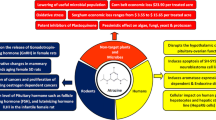Abstract
A rapid and simple HPLC method has been developed for the quantitation of 4-chloro-2-methylphenoxyacetic acid (MCPA) in both wheat and soil samples. Samples were extracted in acidic media and cleaned up by solid-phase extraction with C18 cartridges before HPLC-DAD detection. The limits of detection and quantification of MCPA were 0.02 ng and 0.01 mg/kg for both wheat and soil. The mean recoveries ranged from 87.1% to 98.2%, and the RSDs ranged from 0.604% to 3.44% for the three spiked levels (0.01, 0.1, 0.5 mg/kg). The proposed method was successfully applied to the analysis of MCPA residues in wheat and soil samples from an experimental field. The dissipation half-lives in soil were calculated to be 3.22 days (Beijing) and 3.10 days (Tianjin), respectively. Direct confirmation of the analytes in real samples was achieved by gas chromatography–mass spectrometry. The results indicated that at harvest time, the residues of MCPA in wheat were well below the maximum residue levels and were safe to apply in wheat.





Similar content being viewed by others
References
Bukowska, B., & Hutnik, K. (2006). 2, 4-D and MCPA and their derivatives: effect on the activity of membrane erythrocytes acetylcholinesterase (in vitro). Pesticide Biochemistry and Physiology, 85, 174–180.
Diaz, L., Porcel, J. L., & Valor, I. (2008). Ultra trace determination of 31 pesticides in water samples by direct injection-rapid resolution liquid chromatography-electrospray tandem mass spectrometry. Anal Chim Acta, 624, 90–96.
Fu, F. F., Xiao, L. X., Wang, W., Xu, L. J., Qi, G. M., et al. (2009). Study on the degradation of 2,4-dichlorophenoxyacetic acid (2,4-D) and 2-methyl-4-chloro-phenoxyacetic sodium (MCPA sodium) in natural agriculture-soils of Fuzhou, China using capillary electrophoresis. Sci Total Environ, 407, 1998–2003.
Gervais, G., Brosillon, S., Laplanche, A., & Helen, C. (2008). Ultra-pressure liquid chromatography-electrospray tandem mass spectrometry for multiresidue determination of pesticides in water. J Chromatogr A, 1202, 163–172.
Group of Analysts of Residues of Pesticides (GARP). (1997). Andef validation of analytical methodologies for determination of pesticides residues. Brazil: Ministry of Agriculture.
Jacobsen, C. S., Keur, P., Lversen, B. V., Rosenberg, P., Barlebo, H. C., Torp, S., et al. (2008). Variation of MCPA, metribuzine, methyltriazine-amine and glyphosate degradation, sorption, mineralization and leaching in different soil horizons. Environ Pollut, 156, 794–802.
Jensen, P. H., Hansen, H. C., Rasmussen, J., & Jacobsen, O. S. (2004). Sorption-controlled degradation kinetics of MCPA in soil. Environ Sci Technol, 38, 6662–6668.
Kundu, S., Pal, A., & Dikshit, A. K. (2005). UV induced degradation of herbicide 2, 4-D. Separation and Purification Technology, 44, 121–129.
Oh, K. H., Ahn, S. K., Yoon, K. H., & Kim, Y. S. (1995). Biodegradation of the phenoxy hericide MCPA by microbial consortia isolated from a rice field. Bull Environ Contam Toxicol, 55, 539–545.
Paszko, T. (2009). Degradation of MCPA in soil horizons of polish agricultural soils. Polish Journal of Environmental Studies, 18(6), 1083–1091.
Smith, A. E., Mortensen, K., Aubin, A. J., & Molloy, M. M. (1994). Degradation of MCPA, 2,4-D, and other phenoxyalkanioc acid herbicides using an isolated soil bacterium. J Agric Food Chem, 42, 401–405.
Zhao, H. Y., Bo, R., Xue, J. Y., Ge, J., & Liu, F. M. (2010). Determination of MCPA residue wheat using high performance tandem mass spectrometry liquid chromatography. Chinese Journal of Pestwide Science, 12(1), 105–108.
Zhao, S. C., Zhu, A. G., Wang, J., & Guo, C. Y. (2009). MCPA residue in maize plant, grain and soil. Agrochemicals, 48(11), 816–817. 826.
Zhuang, W. J. (2010). The global regulations on maximum residue limits (MRLs) for pesticides in foodstuffs and feedstuffs. Beijing: Chemical Industry Press.
Acknowledgments
The authors of this paper are thankful to Shandong Weifang Rainbow Chemical Co. Ltd. (Shandong, China) and the Institute for the Control of Agrochemicals, Ministry of Agriculture of the People's Republic of China.
Author information
Authors and Affiliations
Corresponding author
Rights and permissions
About this article
Cite this article
Hu, J., Yang, T., Yin, S. et al. Dissipation and residue of MCPA (4-chloro-2-ethylphenoxyacetate) in wheat and soil. Environ Monit Assess 184, 5017–5024 (2012). https://doi.org/10.1007/s10661-011-2317-y
Received:
Accepted:
Published:
Issue Date:
DOI: https://doi.org/10.1007/s10661-011-2317-y



